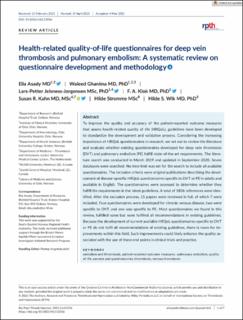| dc.contributor.author | Asady, Elia | |
| dc.contributor.author | Ghanima, Waleed | |
| dc.contributor.author | Jelsness-Jørgensen, Lars-Petter | |
| dc.contributor.author | Klok, F. A. | |
| dc.contributor.author | Kahn, Susan R. | |
| dc.contributor.author | Strømme, Hilde | |
| dc.contributor.author | Wik, Hilde Skuterud | |
| dc.date.accessioned | 2022-10-21T12:57:09Z | |
| dc.date.available | 2022-10-21T12:57:09Z | |
| dc.date.created | 2021-11-10T08:55:36Z | |
| dc.date.issued | 2021 | |
| dc.identifier.citation | Research and Practice in Thrombosis and Haemostasis. 2021, 5 (5), Artikkel e12556. | en_US |
| dc.identifier.issn | 2475-0379 | |
| dc.identifier.uri | https://hdl.handle.net/11250/3027612 | |
| dc.description.abstract | To improve the quality and accuracy of the patient-reported outcome measures that assess health-related quality of life (HRQoL), guidelines have been developed to standardize the development and validation process. Considering the increasing importance of HRQoL questionnaires in research, we set out to review the literature and evaluate whether existing questionnaires developed for deep vein thrombosis (DVT) and pulmonary embolism (PE) fulfill state-of-the-art requirements. The literature search was conducted in March 2019 and updated in September 2020. Seven databases were searched. No time limit was set for the search to include all available questionnaires. The inclusion criteria were original publications describing the development of disease-specific HRQoL questionnaires specific to DVT or PE in adults and available in English. The questionnaires were assessed to determine whether they fulfill the requirements in the latest guidelines. A total of 3826 references were identified. After the exclusion process, 15 papers were reviewed in full, of which 7 were included. Four questionnaires were developed for chronic venous disease, two were specific to DVT, and one was specific to PE. Most questionnaires we found in this review, fulfilled some but none fulfilled all recommendations in existing guidelines. Because the development of current available HRQoL questionnaires specific to DVT or PE do not fulfil all recommendations of existing guidelines, there is room for improvements within this field. Such improvements could likely enhance the quality associated with the use of these end points in clinical trials and practice. | en_US |
| dc.language.iso | eng | en_US |
| dc.publisher | Wiley | en_US |
| dc.rights | Attribution-NonCommercial-NoDerivatives 4.0 Internasjonal | * |
| dc.rights.uri | http://creativecommons.org/licenses/by-nc-nd/4.0/deed.no | * |
| dc.subject | embolism and thrombosis | en_US |
| dc.subject | patient-reported outcome measures | en_US |
| dc.subject | pulmonary embolism | en_US |
| dc.subject | quality of life | en_US |
| dc.subject | surveys and questionnaires | en_US |
| dc.subject | thrombosis | en_US |
| dc.subject | venous thrombosis | en_US |
| dc.title | Health-related quality-of-life questionnaires for deep vein thrombosis and pulmonary embolism: A systematic review on questionnaire development and methodology | en_US |
| dc.type | Peer reviewed | en_US |
| dc.type | Journal article | en_US |
| dc.description.version | publishedVersion | en_US |
| dc.rights.holder | © 2021 The Authors. | en_US |
| dc.subject.nsi | VDP::Medisinske Fag: 700::Klinisk medisinske fag: 750 | en_US |
| dc.source.volume | 5 | en_US |
| dc.source.journal | Research and Practice in Thrombosis and Haemostasis | en_US |
| dc.source.issue | 5 | en_US |
| dc.identifier.doi | 10.1002/rth2.12556 | |
| dc.identifier.cristin | 1953011 | |
| dc.source.articlenumber | e12556 | en_US |
| cristin.ispublished | true | |
| cristin.fulltext | original | |
| cristin.qualitycode | 1 | |

